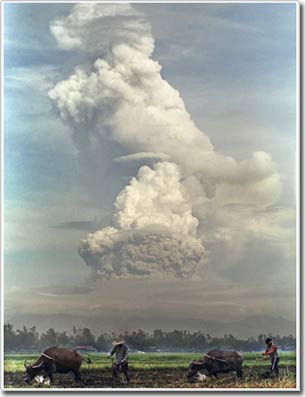Global darkness is related to volcanic eruptions
A huge cloud of dust - covering the sun in 536 AD pushed the world half into a terrible cold - as a result of the eruption of a super volcano, new research shows.
The cause of global darkness in the 6th century has become a subject of debate for a long time. But an international research team has discovered a molecule of sulphate, a sign of eruption, in Greenland ice. This was the first natural evidence for the 536 AD event, according to ancient texts from Central America, Europe and Asia that brought cold night to ruin crops, spark war and contribute Plague spread section.
Scientists have suspected that the giant haze is the result of volcanic eruption or a comet collision. However, researchers have failed to uncover evidence for the disaster before.
 (Photo: Bullit Marquez / AP) 'There is currently no need to cite an extraterrestrial collision as a cause, because the current evidence is convincing enough to conclude that it is definitely a volcano. great ' - said researcher Keith Briffa of the University of East Anglia in the United Kingdom.
(Photo: Bullit Marquez / AP) 'There is currently no need to cite an extraterrestrial collision as a cause, because the current evidence is convincing enough to conclude that it is definitely a volcano. great ' - said researcher Keith Briffa of the University of East Anglia in the United Kingdom.
This finding has been described in detail in the latest issue of Geophysical Research Letters .
Global ash
Tests showed that Greenland's sulfate molecules were deposited between AD 533 and 536, similar to a sulphate found in an ice core in Antarctica.
The team suspected that the eruption occurred near the equator, because its ash fly around the globe.
The Greenland analysis is also consistent with data from treewood around the Northern Hemisphere, showing a decline in growth lasting more than a decade beginning in 536 AD.
'Strangely, the cooling effect of the eruption did not extend to the Southern Hemisphere' scientists said.
Wood grain imprints suggest that the 6th century eruption was larger than the Indonesian Mount Tambora eruption in 1815 - also shaded the sun.
The volcanic home at Los Alamos National Laboratory in New Mexico said that although there was strong evidence of a terrible volcanic eruption, it could not rule out an outer collision.
'More than two thirds of the Earth's surface is covered by water, the erosion process has quickly wiped out all traces of the collision, so the understanding of the time of the disaster in the past remains unfinished. To confirm their hypothesis, volcanic proponents need to find the layer of ash still deposited after the eruption. ' Wohletz said.
William Ryan, an oceanographer at Columbia University's Earth Observatory in New York, believes that finding ash is just a matter of time. Ryan said: 'I feel we have not searched thoroughly, but this presentation will start for a hunt.'
Permanent traces
According to old records, the dust cloud that has existed for more than a year has left an indelible mark in human history. Chinese historians have documented hunger and cold prices many years after the disaster. Around the same time, a Mongolian tribe named Avars migrated westward to eventually establish an empire in Europe.
Historians say this group of people may have left their homeland when the fields of their horses were dried up under the dark sky. Some historians also claim that the drought caused by dust clouds contributes to the decline of the Mesoamerican city of Teotihuacan.
The spread of plague across Europe and the Middle East, the rise of Islam and the collapse of the Roman Empire are also bound to this disaster.
The risk remains
If a similar volcanic eruption occurs today, its devastating effects will be terrible, experts said. The decline in sunshine and ash can affect agriculture around the world. The thick layer of ash can damage the communication system.
'Most aircraft cannot fly in volcanic dust clouds. And these dust clouds with huge potentials can damage radio communications, " Wohletz said.
The worse it is when in fact, people cannot do anything to prevent a disaster from happening or reduce its harm.'In today's society, we still have no less dependence on nature than before. In fact, we may be more dependent. '
- Effect of volcanic eruption phenomenon
- Volcanic activity makes the Earth cooler
- Overwhelmed with volcanic eruptions
- What happens when volcanoes erupt under a glacier?
- Stunning images of volcanic eruptions when viewed from above
- Find the key to predict the volcanic eruption
- The most brilliant volcanic eruption in the solar system
- Volcanic eruptions create new islands
- Global warming and volcanic impact
- 11 most terrifying eruptions in history
- Breathtaking spectacle
- Indonesia was shaken by volcanic eruptions and earthquakes
 'Fine laughs' - Scary and painful torture in ancient times
'Fine laughs' - Scary and painful torture in ancient times The sequence of numbers 142857 of the Egyptian pyramids is known as the strangest number in the world - Why?
The sequence of numbers 142857 of the Egyptian pyramids is known as the strangest number in the world - Why? History of the iron
History of the iron What is alum?
What is alum?